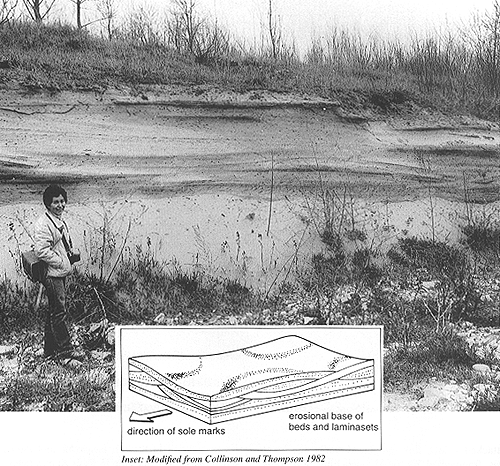
Hummocky cross-bedding
Plate 47

Hummocky cross-bedding
Plate 47
This term defines a variety of low-angle cross-lamination in which laminae are not planar but curved surfaces. Both convex and concave curvatures are recognizable: part of them is outlined by depositional laminae, and part by erosional surfaces. The preservation of these bed forms is thus partial, because some cancellation is inherent to their formative process. The cancellation is normally selective, affecting the protruding parts (hummocks) more, but does not spare the intervening depressions (swales). Hummocks and swales are not linear features like ripples and dunes (see inset). They have not been seen or photographed on the sea bottom, and their geometry has been inferred from stratigraphic sections. Cutting the structure at various angles, for example, one never gets a preferential dip direction of laminae; they have a quaquaversal, or periclinal attitude, and the same low angle of inclination in every direction. These forms, then, are not migratory, or little so. In scale, they are mostly in the range of dunes (see an exception in next plate).
Hummocky cross-bedding is regarded as the product of strong waves impinging on the bottom during storms. These waves have often the power not only of canceling ripples and putting sand in suspension, but also of eroding the bottom. Storm waves are highly turbulent, which means that sand can remain suspended while conditions of maximum energy persist (normal waves support only mud). When water motion and turbulence decrease, sand grains settle but are entrained horizontally by still strong oscillatory movements. Tractive laminae thus develop, although traction cannot last long as the energy wanes and more sedimentation takes place. The formation of hummocks should be, in conclusion, a short-lived process associated with a catastrophic event. The peculiar dynamics of this kind of events explain why the hummocks do not remain visible on the sedimentary interface: they are either buried by the finer suspended sediment or remolded by normal waves (overprinting them with ripples), or both.
When hummocks are eroded by subsequent erosion, concave-up surfaces are preferentially preserved: the structure is then described by the term swaley cross-bedding (or flat festoons).
The outcrop is part of the Pleistocene littoral sands on the Adriatic margin of northern Apennines
| Inset: Modified from Collinson and Thompson 1982 |